UPI Transaction Charges: Will You Have to Pay for UPI Transactions Soon? RBI’s New Hint

UPI Transaction Charges: We all know that Unified Payments Interface or UPI transactions in India are completely free. It is because of this convenience that India is one of the world’s leading countries in digital transactions today. But have you ever wondered who bears the real cost behind this ‘free’ service? In today’s post, we will discuss the hidden costs behind these free UPI transactions and their future.
The Hidden Costs of UPI Transactions
When we send money to a shop or an individual using UPI, we don’t have to pay any extra charges. But this doesn’t mean that there is no cost behind this transaction. Several entities are involved in every UPI transaction, and each of them has to bear some cost.
- UPI Payment Platforms: Companies like Google Pay, PhonePe, and Paytm have to spend a lot of money on their cloud servers, bandwidth, and security monitoring.
- NPCI: The National Payments Corporation of India (NPCI) is the backbone of the UPI system. They have to manage massive data centers that process thousands of transactions per second. According to experts, the cost for NPCI per transaction is about 60 to 70 paise.
- Banks: The banks of both the sender and the receiver have to perform tasks like verifying customer information, checking balances, debiting or crediting money, and sending SMS alerts. Banks have to spend about 12 paise for each SMS. In addition, there are also indirect costs like electricity, software licenses, and payment gateway fees.
According to industry experts, the total cost per UPI transaction can range from 80 paise to ₹1.5.
Financial Strain on Banks and Payment Platforms
The Government of India has mandated keeping UPI free to encourage digital transactions. As a result, this huge cost has to be borne by the banks and UPI platforms. As of June 2025, over 60 crore UPI transactions take place in India every day. This means that banks and UPI platforms are collectively spending over ₹90 crore daily, which amounts to about ₹32,850 crore annually.
Get Instant News Updates!
Join on TelegramIn no other major economy in the world are digital transactions free for end-users. There, these costs are borne by banks, merchants, or payment aggregators and are passed on to customers through various fees.
The Future of UPI: Will It Remain Free?
The government’s main goal was to promote financial inclusion. However, since March 2023, banks and UPI platforms have been lobbying the Reserve Bank of India (RBI) and NPCI to allow them to charge for UPI transactions. According to them, the current system is not sustainable in the long run.
RBI Governor Sanjay Malhotra has indicated that UPI cannot remain free forever. From August 1, 2025, ICICI Bank became the first to charge payment aggregators for UPI transactions, and it is expected that other banks will follow suit soon. While this fee does not yet directly affect users, it is squeezing payment aggregators, who are likely to pass this cost on to merchants and, in the future, to customers.
The question now is, if users have to bear the cost of UPI transactions, will they continue to use it as before? Only time will tell.

